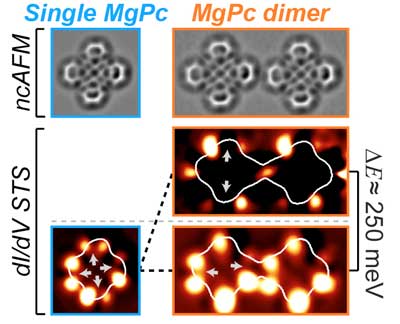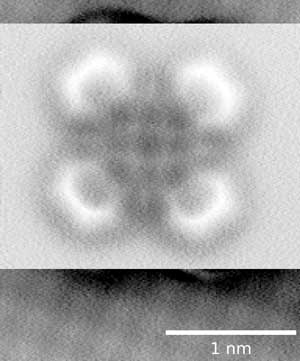| Feb 15, 2021 |
Harnessing socially-distant molecular interactions for future computing
(Nanowerk News) Could long-distance interactions between individual molecules forge a new way to compute?
|
|
Interactions between individual molecules on a metal surface extend for surprisingly large distances – up to several nanometers.
|
|
A new study (Small, "Long-Range Surface-Assisted Molecule-Molecule Hybridization") of the changing shape of electronic states induced by these interactions, has potential future application in the use of molecules as individually addressable units.
|
|
For example, in a future computer based on this technology, the state of each individual molecule could be controlled, mirroring binary operation of transistors in current computing.
|
Measuring socially-distant molecular interactions on a metal surface
|
|
The Monash-University of Melbourne collaboration studied the electronic properties of magnesium phthalocyanine (MgPc) sprinkled on a metal surface.
|
|
MgPc is similar to the chlorophyll responsible for photosynthesis.
|
 |
| Single and paired MgPc molecules. While molecular structure remains unaffected by the presence of the neighbouring molecule (atomic force microscopy images, top), electron distribution (scanning tunneling spectroscopy maps, bottom) is significantly altered. (Image: FLEET)
|
|
By careful, atomically-precise scanning probe microscopy measurements, the investigators demonstrated that the quantum mechanical properties of electrons within the molecules – namely their energy and spatial distribution – are significantly affected by the presence of neighbouring molecules.
|
|
This effect – in which the underlying metal surface plays a key role – is observed for intermolecular separation distances of several nanometres, significantly larger than expected for this kind of intermolecular interaction.
|
|
These insights are expected to inform and drive progress in the development of electronic and optoelectronic solid-state technologies built from molecules, 2D materials and hybrid interfaces.
|
Directly observing changes in molecular orbital symmetry and energy
|
|
The phthalocyanine (Pc) ‘four leaf clover’ ligand, when decorated with a magnesium (Mg) atom at its centre, is part of the chlorophyll pigment responsible for photosynthesis in bio organisms.
|
|
Metal-phthalocyanines are exemplary for the tunability of their electronic properties by swapping the central metal atom and peripheral functional groups, and their ability to self-assemble in highly ordered single layers and nanostructures.
|
 |
| The distinctive cloverleaf phthalocyanine (Pc), when decorated with a magnesium (Mg) atom at its centre, is part of the chlorophyll pigment responsible for photosynthesis in bio organisms (AFM image). (Image: FLEET)
|
|
Cutting- edge scanning probe microscopy measurements revealed a surprisingly long-range interaction between MgPc molecules adsorbed on a metal surface.
|
|
Quantitative analysis of the experimental results and theoretical modelling showed that this interaction was due to mixing between the quantum mechanical orbitals – which determine the spatial distribution of electrons within the molecule – of neighbouring molecules. This molecular orbital mixing leads to significant changes in electron energies and electron distribution symmetries.
|
|
The long range of the intermolecular interaction is the result of the adsorption of the molecule on the metal surface, which “spreads” the distribution of the electrons of the molecule.
|
|
“We had to push our scanning probe microscope to new limits in terms of spatial resolution and complexity of data acquisition and analysis”, says lead author and FLEET member Dr Marina Castelli.
|
|
“It was a big shift in thinking to quantify the intermolecular interaction from the point of view of symmetries of spatial distribution of electrons, instead of typical spectroscopic shifts in energy, which can be more subtle and misleading. This was the key insight that got us to the finish line, and also why we think that this effect was not observed previously.”
|
|
“Importantly, the excellent quantitative agreement between experiment and atomistic DFT theory confirmed the presence of long-range interactions, giving us great confidence in our conclusions”, says collaborator Dr Muhammad Usman from the University of Melbourne.
|
|
The outcomes of this study can have great implications in the development of future solid-state electronic and optoelectronic technologies based on organic molecules, 2D materials and hybrid interfaces.
|


